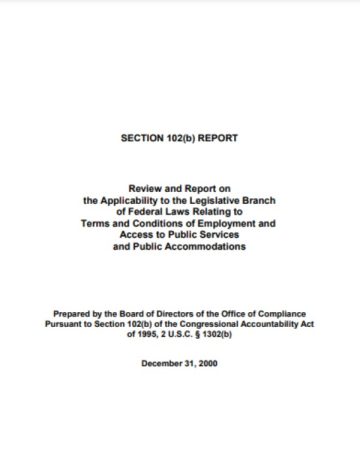Section 102(a) of the Congressional Accountability Act (CAA) lists the eleven laws that, “shall apply, as prescribed by this Act, to the legislative branch of the Federal Government.”1 Section 102(b) directs the Board of Directors (Board) of the Office of Compliance (Office) to:
review provisions of Federal law (including regulations) relating to (A) the terms and conditions of employment (including hiring, promotion, demotion, termination, salary, wages, overtime compensation, benefits, work assignments or reassignments, grievance and disciplinary procedures, protection from discrimination in personnel actions, occupational health and safety, and family and medical and other leave) of employees, and (B) access to public services and accommodations.
And, on the basis of this review,
[b]eginning on December 31, 1996, and every 2 years thereafter, the board shall report on (A) whether or to what degree the provisions described in paragraph (1) are applicable or inapplicable to the legislative branch, and (B) with respect to provisions inapplicable to the legislative branch, whether such provisions should be made applicable to the legislative branch.
I. Background
In December of 1996, the Board completed its first biennial report mandated under section 102(b) of the CAA (1996 Section 102(b) Report or 1996 Report).2 In that Report the Board reviewed and analyzed the universe of federal law relating to labor, employment and public access, made initial recommendations, and set priorities for future reports. To conduct its analysis, the Board organized the provisions of federal law according to the kinds of entities to which they applied, and systematically analyzed whether and to what extent they were already applied to the legislative branch or whether the legislative branch was already covered by other comparable legislation. This analysis generated four comprehensive tables of laws which were categorized as: (1) provisions of law generally applicable in the private sector and/or in state and local government that also are already applicable to entities in the legislative branch, a category which included nine of the laws made applicable by the CAA; (2) provisions of law that apply only in the federal sector, a category which included the two exclusively federal-sector laws applied to the legislative branch by the CAA; (3) private-sector and/or state- and local-government provisions of law that do not apply in the legislative branch, but govern areas in which Congress has already applied to itself other, comparable provisions of law and; (4) private-sector laws which do not apply or have only very limited application in the legislative branch.
The Board then turned to its task of recommending which statutes should be applied to the legislative branch. In light of the large body of statutes that the Board had identified and reviewed, the Board determined that it could not make recommendations concerning every possible change in legislative-branch coverage. In setting its priorities for making recommendations from among the categories of statutes that the Board had identified for analysis and review, the Board sought to mirror the priorities of the CAA. Because legislative history suggested that the highest priority of the CAA was the application of private-sector protections to congressional employees where those employees had little or no protection, the Board focused its recommendations in its first report on applying the private-sector laws not currently applicable to the legislative branch.
